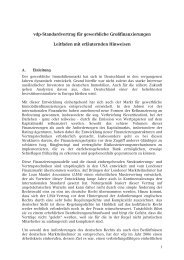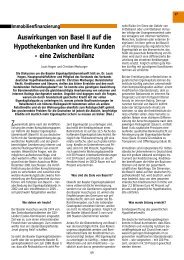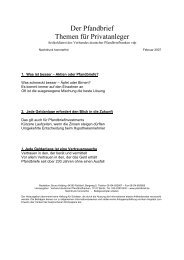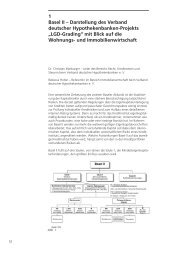The Pfandbrief 2011 | 2012
The Pfandbrief 2011 | 2012
The Pfandbrief 2011 | 2012
Create successful ePaper yourself
Turn your PDF publications into a flip-book with our unique Google optimized e-Paper software.
explain the new assumptions and the model now being used. Are the agencies acting too early<br />
and unnecessarily unsettling market participants, or do their activities comply with the applicable<br />
rules? <strong>The</strong> agencies are required by Article 8, paragraph 6 of the EU Regulation to make<br />
a public announcement if they change their methodologies or models. In addition, they must<br />
announce how many ratings they expect to be affected by the changes.<br />
Making Consultations Mandatory<br />
Clearly, there are varying interpretations of the Regulation’s wording concerning the correct<br />
timing of announcements. From the issuer’s point of view, an agency should not already implement<br />
rating measures or announce possible measures if it has only just begun to consider<br />
changes to the underlying methodology or the models being used. <strong>The</strong> previous examples suggest<br />
that the agencies see things differently. <strong>The</strong>refore, the Regulation should clearly state that<br />
a rating agency may make an announcement only if its internal deliberations have moved far<br />
enough along that they can be disclosed to market participants.<br />
Likewise, the Regulation should stipulate that agencies need to give interested market participants<br />
an opportunity to comment before definitively implementing new methods or models.<br />
This would, for example, enable investors to contribute, thereby avoiding misunderstandings.<br />
In addition, this would give market players time to adjust to the reforms.<br />
Increasing the Transparency of the Models Used<br />
In terms of rating agency transparency, the Regulation needs to be amended, too. Although<br />
the existing Regulation contains a series of rating agency transparency requirements, one<br />
thing has not changed in the process: the methodologies and especially the models used are<br />
not logically or consistently comprehensible to third parties, i.e. to issuers, investors and other<br />
market participants; plausibility tests are virtually impossible using the general model descriptions<br />
given. This means that one of the main objectives of the Regulation has not been fully<br />
accomplished so far.<br />
Naturally, rating agencies are reluctant to fully disclose their models, as they do not wish to<br />
divulge their know-how; moreover, they are afraid of losing contracts. Nevertheless, investors<br />
and issuers have a right to know how the models work. Which detailed assumptions are used?<br />
How do these assumptions affect the model’s calculations? How are certain data incorporated<br />
into the models? For example, knowing the simulated default probabilities of cover assets<br />
would be critical in analysing <strong>Pfandbrief</strong>e. What kind of default histories for cover assets are<br />
used by the agency? What are the assumptions based on?<br />
For issuers and investors, more detailed disclosure requirements for the rating agencies<br />
would be desirable. Investors will only be in a position to reach an informed opinion if they are<br />
able to understand how a rating was arrived at. At the same time, they can draw conclusions<br />
for their own analyses based on the identified strengths and weaknesses of individual methodologies<br />
and models, thereby becoming less dependent on the rating agencies’ assessments.<br />
77
















